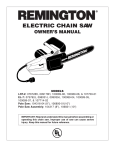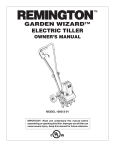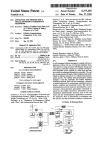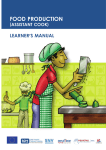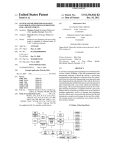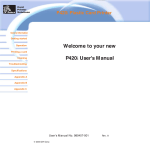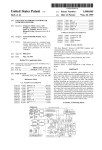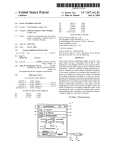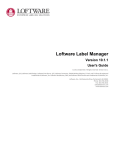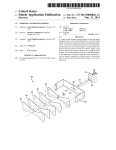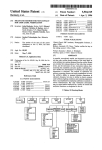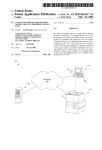Download t, m w i cry
Transcript
IJS20140372325A1
(19) United States
(12) Patent Application Publication (10) Pub. No.: US 2014/0372325 A1
Zambrana et al.
(43) Pub. Date:
Dec. 18, 2014
(54)
Related US. Application Data
SYSTEM, METHOD AND COMPUTER
PROGRAM PRODUCT FOR REGISTERING
PRODUCTS AND PROMOTING CUSTOMER
RELATIONSHIPS
(63)
Continuation of application No. 13/869,527, ?led on
Apr. 24, 2013.
(60) Provisional application No. 61/637,536, ?led on Apr.
(71) Applicant: ElectroluX Home Products, Inc.,
24, 2012.
Charlotte, NC (US)
(72)
Publication Classi?cation
Inventors: Robert Erik Zambrana, Charlotte, NC
(US); Deonn Crumley Baker,
(51)
Int. Cl.
(52)
US. Cl.
G06Q 30/00
Huntersville, NC (US); James Steven
Evans, Winterville, NC (US)
(2006.01)
CPC
G06Q 30/012 (2013.01)
USPC
........................................................ ..
705/302
(73) Assignee: ElectroluX Home Products, Inc.
(57)
(21) Appl. No.: 14/476,501
Regarding a product that is provided by a provider and
received by a recipient, registration of the product and fol
lowing-up With the recipient may be facilitated by way of
ABSTRACT
web-based, symbology-driven product registration systems
(22) Filed:
Sep. 3, 2014
andmethods.
H
H
/
//
//”'_TT‘\\
\\
L4
\\
/
\\
/
l
L3
/
/
20
,1
t,
I
de
%
\
m
\ (0
\
l
g
\
10
\
I
x :
w i
'
‘
w \
cry ;
l
0))
/
I
Patent Application Publication
Dec. 18, 2014 Sheet 1 0f 11
/
\
/
/
/
/
//
/
\
a @w \
S
E1
\
\\
\
/
I
I
\
\
/
NI
<1-
__
NI
m
|
\
.____
\
2
\
\\
x
*g]
KJ
\
US 2014/0372325 A1
I
I
2|
/I
\
//‘\
\\
QI
r—
/
\\
m
?lm
/
N
F'
//
\
\\\
Q/ /
/
//
F
cs;
M
U
V
a:
a
2
a
V
i1
1
:2
no
I
Patent Application Publication
Dec. 18, 2014 Sheet 2 0f 11
FIGS 2
US 2014/0372325 A1
Patent Application Publication
Dec. 18, 2014 Sheet 3 0f 11
US 2014/0372325 A1
BRAND AND/0R OTHER INFORMATION
PRODUCT REGISTRATION
LANGUAGE PREFERENCE:
NAME:
ENGLISH E]
FIRSTNAMEI I:
LAST NAME: L
1
ADDRESS:
IAUTOFILL RECOMMENDED IF ENABLED)
ADDRESS I:
I
ADDRESS 2:
|SELECT A STATE/PROVINCE EDI
("A :
ZIP/POSTAL cone: :: COUNTRY: USA EI
PRODUCT INFORMATION:
DATE or PURCHASE: l:
PLA(E OF PURCHASE:
|
*PLEASE VERIFY THIS INFORMATION IS (0RRECT*
FIG. 3
Patent Application Publication
Dec. 18, 2014 Sheet 4 0f 11
US 2014/0372325 A1
Patent Application Publication
Dec. 18, 2014 Sheet 5 0f 11
US 2014/0372325 A1
5
FIG.
Patent Application Publication
Dec. 18, 2014 Sheet 6 0f 11
US 2014/0372325 A1
6
FIG.
Patent Application Publication
Dec. 18, 2014 Sheet 7 0f 11
US 2014/0372325 A1
16
16
/@
l
l
OOO
D
@ @@®(
m)(
Q)
:1
CI:
U
Go
00
M/zb?
DO
C) (:D
i}
g
34
32
®
6’:
I‘bo ‘ ||
|t>o I H
36
\
Patent Application Publication
Dec. 18, 2014 Sheet 8 0f 11
PROVISION OF
INITIAL DATA
70
DELIVERY OF
INITIAL DATA
75
1
RECEIVE
COMMUNKATION
FROM RECIPIENT AND
PROMOTE
RELATIONSHIP WITH
RECIPIENT
80
FIG. 8
US 2014/0372325 A1
Patent Application Publication
Dec. 18, 2014 Sheet 9 0f 11
US 2014/0372325 A1
RECEIVE AT LEAST
SHORTENED URL
LIN)
PRODUCT PREVIOUSLY
REGISTERED
"
PROVIDE
E
ms
"‘
PROVIDE
REGISTRATION
WEBSITE
RELATIONSHIP
WEBSITE
m
1.29
RECEIVE-
T
T
R msmgggg RELA ED
E
COMMUNICATE WITH
REGISTER PRODUCT
ASIIRCLITIRTILTRHUORLLTIEILLED
RECIPIENT
L55
130
RELATIONSHIP WEBSITE
_
15.0
DOES
RECIPIENT HAVE
ASSOCIATE
ACCOUNT FOR
WEBSITE
RELATIONSHIP
YES
~
m
“(gum
145
l
ESTABLISH
RELATIONSHIP
ACCOUNT FOR
RECIPIENT
up
FIG. 9
Patent Application Publication
200
Dec. 18, 2014 Sheet 11 0f 11
US 2014/0372325 A1
\
USER INTERFACE
m
moouus
21g
F"
_
_
—
_
_
— _
_
_
_
—
—
_
~
_
_
_
h
_
_‘_"1
i -
MODULE
2m
-—
{
‘
i
‘
1
'
: i
i
PROCESSOR
MEMORY
{
m
m
:
|
1
PRO(ESSING(IRCUITRY
I
MODULE
'
|
I
2_19
' ------------------- --1
2L0
COMMUNICTION
INTERFACE
gig
FIG. 11
Dec. 18, 2014
US 2014/0372325 A1
SYSTEM, METHOD AND COMPUTER
apparatus receiving the recipient’ s personal information from
PROGRAM PRODUCT FOR REGISTERING
PRODUCTS AND PROMOTING CUSTOMER
RELATIONSHIPS
the web browser of the recipient’s mobile device, at least
partially in response to sending the webpage. The method
CROSS-REFERENCE TO RELATED
APPLICATION
[0001]
This application is a continuation application of
US. application Ser. No. 13/869,527, ?ledApr. 24, 2013, that
claims the bene?t of US. Provisional Application No.
61/637,536, ?led Apr. 24, 2012, which are incorporated
herein by reference in their entirety and for all purposes.
BACKGROUND
[0002]
It is typical for companies to have Customer Rela
tionship Management (“CRM”) systems for use in fostering
relationships with customers. CRM systems typically com
prise a computer database in which customer information is
associated with product registration information. For
example, when a customer purchases a product, the product
may be accompanied by a product registration card that the
customer may ?ll out, so that the completed product registra
tion card includes information about both the customer and
the product. Then, the customer may mail the completed
registration card to the company or its agent, and the infor
mation from the card may be entered into the CRM computer
database for future use by the company. For example, the
CRM computer database may be used for handling product
recalls and/or for soliciting extended service warranty busi
may further comprise the portal apparatus associating the
recipient’s personal information with the information from
the provider about the product identi?ed by the decodable
product identi?er, for product registration purposes.
[0006] Thereafter, the provider may follow up with the
recipient, comprising using at least some of the associated
personal and product information for communicating with
the recipient. Also, for each recipient, a unique relationship
account may be established and associated with all of the
recipient’s registered products, such as for enhancing the
relationship between the provider and the recipient. In this
regard, subsequent receipt of the above-discussed URL from
the recipient may result in another webpage being provided to
the recipient, wherein the another webpage has associated
therewith information about and/or tailored to one or more of
(e.g., all of) the recipient’s registered products.
[0007]
that is presented later. Other aspects of this disclosure will
become apparent from the following.
BRIEF DESCRIPTION OF THE DRAWINGS
ness.
[0003]
There are barriers in current product registration
The foregoing presents a simpli?ed summary in
order to provide a basic understanding of some aspects of this
disclosure. This summary is not an extensive overview and is
not intended to identify key or critical elements of the inven
tion or to delineate the scope of the invention. The purpose of
this section is to present some concepts of the disclosure in a
simpli?ed form as a prelude to the more detailed description
[0008]
Having described some aspects of this disclosure in
processes. For example, product registrations cards may need
to be printed in different languages. Also, customers fre
quently do not complete and return product registration cards.
general terms, reference will now be made to the accompa
nying drawings, which are not necessarily drawn to scale. The
drawings are exemplary only, and should not be construed as
SUMMARY
limiting the invention.
[0009] FIG. 1 schematically illustrates aspects of systems
[0004]
One aspect of this disclosure is the provision of
web-based, symbology-driven product registration systems
and methods.
[0005] In accordance with one aspect of this disclosure, a
method for registering a product, which is provided by a
provider (e.g., company) and received by a recipient (e.g.,
consumer), comprises associating at least one symbology
with the product, wherein the at least one symbology com
prises a decodable URL for at least indirectly accessing a
website comprising a webpage, and the at least one symbol
ogy is con?gured to be imaged and decoded at least by a
mobile device associated with the recipient. Associated with
the URL is at least one product identi?er of a plurality of
different product identi?ers. The method may further com
prise associating the product identi?er with information from
the provider about the product in at least one computer data
base, wherein at least some of the information about the
product varies between products. The method may further
comprise a portal apparatus receiving the URL from a web
browser of a recipient’s mobile device. The method may
further comprise the portal apparatus sending the webpage to
and methods for registering products, in accordance with a
?rst embodiment of this disclosure.
[0010]
FIG. 2 is a more detailed view of a representative
matrix code symbology schematically shown in FIG. 1.
[0011] FIG. 3 illustrates a Product Registration Webpage in
accordance with the ?rst embodiment.
[0012] FIGS. 4-7 schematically illustrate aspects of an
exemplary method and associated features, in accordance
with ?rst and second embodiments of this disclosure.
[0013] FIG. 8 is a process ?ow diagram illustrating an
exemplary overall process associated with at least registering
a product that is provided by a provider and received by a
recipient, in accordance with an aspect of this disclosure.
[0014] FIG. 9 is a process ?ow diagram illustrating an
exemplary process that may be performed by a portal appa
ratus, for receiving communications from recipients and pro
moting relationships with recipients, in accordance with an
aspect of this disclosure.
[0015] FIG. 10 illustrates a Relationship Webpage in accor
the web browser of the recipient’s mobile device at least in
response to receiving the URL from the web browser of the
dance with an exemplary embodiment of this disclosure.
recipient’s mobile device, wherein the webpage includes
?elds for receiving personal information from the recipient
for registering the product identi?ed by the decodable prod
a portal apparatus that may be implemented on one or more
devices of this disclosure, and that may be operative for at
least partially providing some of the features of this disclo
uct identi?er. The method may further comprise the portal
sure.
[0016]
FIG. 11 illustrates a block diagram of, for example,
Dec. 18, 2014
US 2014/0372325 A1
DETAILED DESCRIPTION
[0017] Exemplary embodiments of this disclosure are
described below and illustrated in the accompanying ?gures,
in which like numerals refer to like parts. The embodiments
described provide examples and should not be interpreted as
limiting the scope of the invention. Other embodiments, and
modi?cations and improvements of the described embodi
ments, will occur to those skilled in the art and all such other
embodiments, modi?cations and improvements are within
the scope of the present invention.
[0018] Referring in greater detail to the drawings, FIG. 1
schematically illustrates aspects of systems and methods for
registering products 10, in accordance with a ?rst embodi
ment of this disclosure. The products 10 may be provided by
a provider, and the provider may be a company having a
facility 12 (e. g., a manufacturing facility (e.g., factory), pack
aging facility, distribution facility and/or any other suitable
type of facility) from which the products originate and/or
through which the products pass. For example and not for the
purpose of limiting the scope of this disclosure, in FIG. 1 a
series of the products 10 at the facility 12 is schematically
shown as traveling along an assembly line, conveyor system,
or the like; whereas another product 10 is proximate a recipi
ent 14 (e.g., customer). In FIG. 1, both the recipient 14 and the
product 10 proximate the recipient are located remotely from
the facility 12. The products 10 may be any suitable products,
such as major appliances for air care, dish care, fabric care,
food preparation, and food preservation; professional prod
ucts; and small domestic appliances. As more speci?c
examples, the products 10 may be appliances, such as kitchen
and/or laundry appliances, although other types of products
are also within the scope of this disclosure. The kitchen appli
together with the computer databases 18 may, optionally, be
located at the facility 12 proximate the computer 24, in which
case the server 26 and the computer 24 may be connected to
one another by way of a local area network.
[0021]
Codes used in the registration process may be
embedded in suitable one-dimensional symbologies, such as
Universal Product Code barcodes. However, two-dimen
sional symbologies 20, such as matrix codes having square or
dot-shaped modules arranged on a grid pattern, or the like,
may be preferred. Of particular interest may be the Quick
Response (“OR”) type of matrix symbologies. An example of
a suitable two-dimensional symbology 20 in the form of a
matrix code symbology is shown in FIG. 2. The registration
related symbologies 20 may be printed by way of a printer 23
simultaneously with other symbologies that are convention
ally associated with products 10.
[0022] More speci?cally regarding the codes embedded in
the symbologies 22 for at least the registration process, these
codes may optionally comprise both a product identi?er and
a universal resource locator (URL) (e.g., a shortened URL),
or the codes embedded in the symbologies may consist essen
tially of, or consist of, URLs (e. g., shortened or short URLs)
that function at least indirectly as, or are otherwise associated
with, product identi?ers. More speci?cally, each product 10 is
identi?ed by a unique identi?er for product registration pur
poses (“product identi?er”) (e.g., typically no two products
have the same product identi?er). For example, the product
identi?er may be a serial number for a product 10, although
the product identi?er is shorter than a typical product serial
number.
[0023] As mentioned above and as will be discussed in
greater detail below, in some embodiments or versions of this
ances may be one or more of an oven, stove, range, warmer,
disclosure, each symbology 20 may be decoded to provide
toaster, dishwasher, refrigerator, freezer, coffee maker,
only a short URL represent. However, this disclosure is not
blender and crock pot. The laundry appliances may be one or
more of a laundry washer, laundry dryer and iron. Other types
limited to such embodiments or versions. For example, in a
of appliances such as, but not limited to, vacuum cleaners are
also within the scope of this disclosure.
respective symbology 20 may include a URL (e.g., a short
[0019]
URL and respective product identi?er are coded and embed
ded into each symbology 20. The URL is for at least indirectly
accessing a portal apparatus comprising a module that is in
the form of and/or for providing a Product Registration Web
In one aspect, the ?rst embodiment pertains to opti
mizing and streamlining the product registration process,
such as by providing the ability for recipients 14 (e.g., cus
tomers) to register products 10 via a website and computer
ized mobile devices 16, such as smart phones. In addition, the
utilization of codes imbedded in symbologies 20 and a com
puter database 18 comprising a look-up table, or the like,
minimizes manual data entry in a manner that saves time and
promotes accuracy, as will be discussed in greater detail
below. The database 18 is shown in FIG. 1 as being associated
with a computer and/or computer server 26, or the like,
located remotely from the facility 12, although the database
18 may be located at the facility and be associated with a
computer 24 at the facility, or the database 18 may be in any
other suitable location(s).
[0020]
The computer 24 and server 26 may be in commu
nication with one another over a ?rst network 28 and/or a
second network 30, and/or the computer 24 and server 26 may
be consolidated together into one or more computers. The
?rst network 28 may be a dedicated network that is separate
from the second network 30, or the ?rst and second networks
28, 30 may be the same network. The ?rst and second net
works 28, 30 may include one or more suitable communica
tion networks, such as, but not limited to, the Internet, cable
television networks, cellular data networks, and/or the public
switched telephone network. Alternatively, the server 26
?rst version of the ?rst embodiment, for each product 10, the
ened URL) and the respective product identi?er. That is, the
site (e. g., a Product Registration Webpage 21 (FIGS. 3 and 7)
of the Product Registration Website). Optionally, the URL
may alternatively or also be for at least indirectly accessing a
module that is in the form of and/or for providing a Relation
ship Website (e.g., a Relationship Webpage (FIG. 10) of the
Relationship Website), as will be discussed in greater detail
below with reference to FIG. 9. The portal apparatus may be,
may consist essentially of, or may comprise the server 26, the
computer 24, and/ or any combination of these or other suit
able features, such that the Product Registration and Rela
tionship Websites may be hosted by the server 26, the com
puter 24, and/ or by any other suitable features.
[0024] In the ?rst version of the ?rst embodiment, the same
URL may be encoded into each of the symbologies 20,
whereas each symbology has a different/unique product iden
ti?er encoded thereinto. In this ?rst version, the product iden
ti?ers may be used to respectively identify the registration
records of the database 18, wherein each registration record
typically contains numerous ?elds for data.
[0025] In a second version of the ?rst embodiment, each
symbology 20 may “hold” (e.g., be decodable to provide)
only a respective short URL, wherein each product 10 may be
Dec. 18, 2014
US 2014/0372325 A1
identi?ed by a respective unique short URL (e. g., typically no
model number) to the server for populating or at least updat
two products have associated therewith the same short URL).
In this second version, the short URLs may be used to respec
ing the look-up table feature, or the like, of the database 18. In
the look-up table feature, or the like, of the database 18,
product identi?ers and/or short URLs may be associated with
tively identify the registration records of the database 18,
wherein each registration record typically contains numerous
?elds for data, such that each short URL may be respectively
associated with a product by way of the product’s serial
number, product identi?er and/or any other suitable identi?
ers, as will be discussed in greater detail below. For example,
the unique short URLs may serve as the unique product
identi?ers.
[0026] In the ?rst embodiment, software module(s) execut
ing on the computer 24 located at the facility 12 (or any other
suitable location) are operative for creating at least the short
URLs, optionally also the product identi?ers, and the sym
bologies 20, and these executing software modules are opera
tive for associating the short URLs and optionally the product
identi?ers with some of the product registration information
(e. g., product serial and model numbers); the symbologies are
printed by the printer 23 located at the facility; and the sym
bologies 20 are respectively associated with products 10 and
associated user manuals at the facility 12, all prior to the
recipient 14 participating in the registration process. As one
example, the symbologies 20 may be respectively printed
any other suitable information (e.g., for facilitating product
registration, servicing, marketing, or the like) for the respec
tive product 10, prior to the recipient 14 participating in the
registration process. For example, the database 18 may com
prise a Customer Relationship Management (“CRM”) com
puter database, and the look-up table may be in combination
with, incorporated into and/or characterized as the CRM
computer database (e. g., the look-up table may be integrated
directly into the CRM computer database).
[0029] The registration records in the database 18 (e.g., the
look-up table and/or CRM data) may be updated with short
URLs and/or product identi?ers and associated product reg
istration information (e.g., product serial and model number)
in real time with the creation of the product identi?es and
symbologies 20, or the updating may occur periodically in a
batch process, typically prior to the recipient 14 participating
in the registration process. For example, the model, serial
numbers and product identi?ers (e.g., short URLs) may be
contained in the database 18 (e. g., CRM computer database)
upon shipment of the associated products 10 from the factory
onto adhesive-backed labels that are respectively stuck onto
12, wherein the model and serial numbers are respectively
the products 10 at the facility 12, all prior to the recipient 14
participating in the registration process. Accordingly, in
FIGS. 1, 2, 5 and 6, each feature identi?ed by reference
associated with the corresponding product identi?ers for later
pairing with other information, as discussed in greater detail
number 20 may be characterized as being illustrative of an
below. That is, the registration records contained in the com
puter database 18 and/or any other suitable location typically
contain the model and serial numbers respectively associated
adhesive-backed label that includes a symbology printed
thereon, although any other suitable methods and features
may be used for associating the symbologies, or the like, with
with short URLs and/or any other suitable product identi?ers
the respective products 10. Typically, for each product 10, its
associated, unique symbology may also be included in the
detail below. The provider (e.g., company or any other suit
user manual for the product.
the database 18 with any other pertinent information at any
for facilitating the registration process discussed in greater
able provider) may further populate the registration records in
[0027] The above-discussed software module(s) executing
suitable point during the provider’s manufacturing or later
on the computer 24 may be incorporated into the existing
batch process (e.g., fed by an Excel brand spreadsheet)
scripted into Loftware brand enterprise label and print man
processes, such as at any suitable time before and/or after the
agement software module(s), although any other suitable fea
ture(s) (e.g., software module(s)) may be utilized. In addition,
ized mobile device 16 having an optical feature (e.g., module)
to capture an image of the registration-related symbology 20
associated with the product 10 they have purchased or other
wise obtained. The optical feature capturing the image of the
the script may go through a series of “GET/POST” param
eters and/or a URL shortening script. The symbologies 20
recipient 14 participates in the registration process.
[0030]
A recipient 14 of a product 10 may use a computer
may be respectively associated with the products by being
symbology may comprise a camera module or other suitable
mounted to the products, mounted to the packaging of the
products, included on registration cards associated with the
optical device module of the recipient’s computerized mobile
device 16 (e.g., smart phone/cell phone). The mobile device
products (e.g., the symbologies may be placed on multilin
gual product registration cards) and/ or the symbologies may
be associated with the products in any other suitable manner.
[0028] At least a portion of one or more of the features,
aspects or steps described as being located at or carried out at
the facility 12 may be located at or carried out in any other
suitable location. For example, the symbologies 20 may be
associated with the products 10 at any suitable location, such
as locations positioned downstream from the factory in the
?ow of goods from the factory. As another example, at least
some of the operations carried out by the computer 24 may be
carried out by the server 26, and vice versa; and the computer
24 and server 26 may operate together to facilitate some
aspects of this disclosure. For example, when the database 18
is associated with the server 26 as shown in FIG. 1, the
computer 24 transmits data (e.g., database registration
records) associating short URLs and/or product identi?ers
with product registration information (e.g., product serial and
16 may decode the captured image of the symbology 20 in a
conventional manner, such as through execution of suitable
software module(s). In accordance with one aspect of this
disclosure, the information decoded from the symbology 20
comprises the URL (e.g., shortened URL), wherein the URL
(e.g., shortened URL) serves as a product identi?er and/or
optionally another product identi?er is embedded in the sym
bology. In response to the decoding of the URL from the
captured image of the symbology 20, the mobile device 16
typically automatically accesses the portal apparatus, or more
speci?cally the Product Registration Website provided by the
portal apparatus, such as by way of the web browser module,
or the like, of the mobile device 16. Reiterating from above,
the portal apparatus and its Product Registration and Rela
tionship Websites may be hosted by the server 26, the com
puter 24, or in any other suitable manner. More speci?cally
and in accordance with the ?rst embodiment, the portal appa
ratus and its Product Registration and Relationship Websites
Dec. 18, 2014
US 2014/0372325 A1
are hosted by the server 26, and the communication between
the mobile device 16 and the portal apparatus is by way of the
network 30, wherein the network may comprise the Internet,
as discussed above. More speci?cally, the mobile device 16
may comprise a transceiver module for communicating with
one or more cellular data networks, for accessing the Internet.
[0031] In response to the mobile device 16 accessing the
portal apparatus, or more speci?cally the Product Registra
tion Website of the portal apparatus, using the symbology 20
for the ?rst time as discussed above, the Product Registration
Webpage 21 typically automatically appears on the display
screen of the mobile device 16. An example of the Product
Registration Webpage 21 is shown in FIG. 3, although the
Product Registration Webpage may be in any other suitable
con?guration. The Product Registration Webpage 21 is con
?gured to be ?lled with product registration information, and
the Product Registration Website is associated with the data
base 18 for data storage and retrieval. In response to accessing
the Product Registration Website and the Product Registra
tion Website receiving the decoded product identi?er (e.g.,
the short URL) as discussed above, the Product Registration
Website identi?es (e.g., software module(s) associated with
the Product Registration Website are executed for identify
ing) predetermined information in the database 18 (e.g., by
way of look-up table(s), or the like) that is associated with the
decoded product identi?er (e.g., the short URL), for further
association with information (i.e., data) input into the Product
Registration Webpage 21. This associating together of the
information may be achieved through operation of the Prod
uct Registration Website (e.g., software module(s) associated
with the Product Registration Website).
[0032] Through operation of the Product Registration Web
site (e.g., software module(s) associated with the Product
and/or edit the ?elds of the Product Registration Webpage 21
(e.g., by way of a keyboard or touchscreen user interface of
the mobile device 16).
[0034] Stated differently, the Product Registration Website
may be optimized speci?cally for mobile users, so that a
simple scan of the symbology 20 by way of a mobile device
code reader application executing on the mobile device 16
will auto-generate the model and serial numbers from the
computerized look-up tables, or the like, of the computer
database 18 using the decoded product identi?er (e.g., the
short URL). Auto-?ll content of a user’s mobile device 16
may be accessed, if enabled. More speci?cally, any personal
information already cached on the mobile device 16 (e.g.,
smart phone) may be automatically uploaded to populate
?elds of the Product Registration Webpage 21. However, this
auto-generation of the personal information would typically
have to be enabled by pre-selecting the auto-?ll function of
the mobile device 16, and typically a user of the Product
Registration Webpage 21 will have to af?rmatively verify that
the data on the Product Registration Webpage is accurate and
ready to upload. The Product Registration Website may pro
vide uploaded data from the mobile device 16 and the respec
tive information from the computerized look-up tables, or the
like, to the CRM computer database in real-time.
[0035] Reiterating, the recipient (e.g., customer or con
sumer) can scan the symbology 20 associated with their prod
uct 10 and automatically be directed to the Product Registra
tion Website, wherein the product identi?er (e.g., the short
URL) decoded from the symbology is automatically
uploaded and used to obtain the model and serial number
from the computerized look-up table, or the like. Additional
information may also be automatically uploaded to the Prod
uct Registration Website, such as name, address, city/state
and zip code information from the recipient’s mobile device
Registration Website), the associated-together information
16, if an “auto-?ll” function on the recipient’s mobile device
may be stored together in the database 18 as a database
(e.g., web browser) is enabled. This automatic uploading of
data drastically reduces time and data input errors, while
increasing operational ef?ciency as data feed may be real
time into the CRM system of registration record. Automati
cally obtaining data in this way also seeks to ensure that the
registration record, or otherwise linked together and saved in
any suitable manner, such as in, or as part of, the computer
ized look-up table, the CRM computer database, or in any
other suitable manner or location. For example, the associ
ated-together information may be referred to as a registration
record, and the registration record may be maintained in the
database 18 (e.g., the CRM computer database). In summary,
the ?elds of the respective registration record may be auto
matically populated with the entries in the computerized
look-up table that are associated with the decoded product
identi?er (e.g., the short URL), and the registration record
may also be populated with the information input into the
Product Registration Webpage 21, e.g., as entered by the
recipient 14 via the computerized mobile device 16. These
operations may be carried out through operation of the Prod
uct Registration Website (e.g., software module(s) associated
with the Product Registration Website).
[0033] The Product Registration Webpage 21 provides for
provider (e.g., company) has accurate product tracking infor
mation for consumer contact opportunities, not limited to
service ?ashes and potential product recall noti?cations.
[0036] The data for products registered online, as discussed
above, may be processed in real-time, and the data may be
immediately passed through to the CRM system of registra
?exible data entry. For example, at least some of the ?elds of
tion record. This process caters to recipients (e.g., consumers
or customers) by allowing for the usage of current technolo
gies, and it also addresses data collection needs of the pro
vider/company, so that the company may, in turn, better ful?ll
consumer needs. In one aspect of this disclosure, previously
used multiple-step processes and redundant actions are
streamlined into a consumer-friendly function that provides
more ef?cient CRM input, yielding greater amounts of ana
lytics data for use in marketing metrics.
the Product Registration Webpage 21 may be automatically
populated with personal information about the recipient 14
uct 10 as discussed above, the Product Registration Website
that is available from their mobile device 16, if the mobile
device has this “auto-?ll” feature and it is enabled. These
may substantially immediately and automatically con?rm the
registration to the recipient by way of the recipients mobile
operations may be carried out through cooperative operation
of the Product Registration Website (e.g., software module(s)
associated with the Product Registration Website) and the
mobile device 16 (e.g., software module(s) associated with
the mobile device). The recipient 14 may also manually input
devices 16, with the con?rmation being in the form of a
con?rming webpage, e-mail noti?cation, a text message noti
[0037]
In response to the recipient 14 registering their prod
?cation, voicemail noti?cation and/ or any other suitable con
?rmation. This con?rmation may be characterized, for
example, as a following-up with the recipient 14, with this
Dec. 18, 2014
US 2014/0372325 A1
following up comprising using at least some of the personal
and product information associated with the registering for
communicating with the recipient. Thereafter, the CRM data
print management software modules may be utilized in cre
ating the labels 40/symbologies 20; however, any other suit
nications may be characterized, for example, as a following
able software, ?rmware and/ or hardware may be used. Also,
the symbologies 20 and text versions 42 of the shortened
URLs contained in the symbologies 20 may be printed on any
suitable substrate, such that the present disclosure is not lim
up with the recipient 14, with this following up comprising
ited to the use of labels 40.
using at least some of the personal and product information
associated with the registering for communicating with the
[0041] As schematically shown in FIG. 5, the tags/labels
40, which typically comprise both the symbologies 20 and the
may be used in a conventional manner or any other suitable
manner to communicate with the recipient 14. These commu
recipient.
[0038] A second embodiment of this disclosure is like the
above-discussed ?rst embodiment, except for variations
noted and variations that will be apparent to one of ordinary
skill in the art. In accordance with the second embodiment,
non-smart phone users are able to use the short URL and/or a
concatenated (e.g., shortened) version of the URL by way of
a standard web browser or by way of audible (e.g., verbal)
communication using a telephone, or the like, as will be
discussed in greater detail below.
[0039] FIGS. 4-7 schematically illustrate aspects of an
exemplary method and associated features, in accordance
with the ?rst and second embodiments of this disclosure. FIG.
4 schematically illustrates, to the left of the arrow in FIG. 4,
that the original format of the base product data (i.e., data
about the products 10 (FIG. 1)) may be in any suitable form
text versions 42 of the shortened URLs contained in the
symbologies, may be mounted to, or otherwise associated
with, the products 10 at the facility 12 (e.g., factory). With
regard to the assembling and packaging line for the products
10 at the facility 12 (e.g., factory), the labels 40 may be paired
with (e. g., mounted to or otherwise associated with) the prod
ucts 1 0 at the point where owner’ s manuals, registration infor
mation and product information are paired with the products.
In this regard, the labels 40 may have an adhesive backing and
may be used in place of, or in addition to, conventional labels
(not shown) that are conventionally mounted to, or otherwise
associated with, the products at the facility 12. For example,
the products 10 may be of any suitable type for which product
identi?cation or registration information is provided to the
recipient 14 (e.g., consumer) with the product (e.g., appli
ance).
such as, but not limited to, one or more modules in the form of
[0042] From the facility 12 (e.g., factory), the products 10
a spreadsheet, tab-delimited text, comma-separated values or
pre-scripted arrays, or any other suitable process-compatible
format may be used. The arrow in FIG. 4 schematically illus
may reach the recipients 14 through any suitable conventional
channels of distribution, commerce, or the like. For example,
FIG. 6 schematically illustrates recipients 14 (e.g., consum
trates that the base product data (e.g., base product data mod
ers) that are in receipt of (e.g., holding) products 10 that they
have, for example, purchased. As should be apparent from the
foregoing, the products 10 may be in many different forms
ules) may be stored on and/or processed by way of one or
more of any suitable electronic devices such as, but not lim
ited to, enterprise-level servers (e.g., web or print servers),
desktop workstations (e. g., for data scrubbing and/or valida
tion) or other databases. As examples, any suf?cient software
language may be used, such as Structured Query Language
(SQL), and the databases may be managed by any suitable
database manager, such as SAP. For example, the base prod
uct data (e.g., base product data modules) may be located at
one or more of the databases 18, computers 24 or servers 26
of FIG. 1. The base product data may be processed and
located in any suitable manner.
[0040]
Referring to FIG. 5 and in accordance with the ?rst
and second embodiments, the base product data (which may
be located at or obtained from, for example, one or more of the
electronic devices shown in FIG. 4) is used in the generating
of (e.g., via execution of one or more software modules) the
symbologies 20 that are to be associated with the products 10
at the facility 12. More speci?cally, a tagging process (e.g.,
labeling process) is used for creating tags (e.g., decal or labels
40) that include the symbologies 20. Even more speci?cally
in accordance with the ?rst and second embodiments, script
and sizes, are not limited to products that may be held by the
recipients 14.
[0043] When the recipients 14 (e.g., consumers) obtain/
receive their products 10, they will have (e. g., at least will be
able to readily obtain) access to the labels 40/symbologies
20/text versions 42 of the shortened URLs associated with
their products. Preferably (e.g., optionally) and as schemati
cally shown in FIG. 6, the recipient 14 scans the symbology
20 associated with (e.g., mounted to) their product 10 with
their computerized mobile device 16 (e.g., smart phone).
[0044] Several nonlimiting examples of mobile devices 16
(e.g., smart phones) are shown in FIG. 7. As schematically
shown in FIG. 7, the mobile device 16 automatically obtains
accesses to the Product Registration Website (e.g., Product
Registration Webpage 21) by way of the web browser, or the
like, of the mobile device in response to the mobile device
scanning the symbology 20 of the label 40 associated with the
product. More speci?cally, scanning the symbology 20
causes the web browser module of the mobile device 16 to be
directed to a predetermined website. Through operation of
ing (e.g., execution of one or more software modules) at the
one or more software modules associated with the portal
print server (e.g., the print server for the printer 23 (FIG. 1))
combines product information variables, URL(s), and inte
grates generation of the symbologies 20 at some point in the
apparatus, a scripted redirection feature of the portal appara
tus checks the referring shortened URL, and matches (e.g.,
labeling process used by the facility 12 (e.g., factory). Script
via a look-up table of database 18 or any other suitable meth
ods and/or devices) the referring shortened URL to the cor
ing at the print server level allows for variable data printing of
custom generated symbologies 20 on the product identi?ca
responding long URL so that the Product Registration
Webpage 21 of the Product Registration Website is displayed
tion labels 40. Also, for each label 40, a text version 42 of the
shortened URL contained in the symbology 20 may be
printed on the label to accommodate for any accessibility
concerns, backwards compatibility and/or manual entry. As at
on the display screen of the mobile device 16 as discussed in
least allude to above, Loftware brand enterprise label and
greater detail below. The URL of the scanned symbology 20
being associated in the database 18 with the information
about the product 10 associated with the scanned symbology
20 facilitates the automatic identi?cation of and the automatic
Dec. 18, 2014
US 2014/0372325 A1
populating of at least some of the ?elds of the Product Reg
istration Webpage 21 displayed on the display screen of the
mobile device 16. In addition, other ?elds of the of the Prod
uct Registration Webpage 21 displayed on the display screen
of the mobile device 16 may be automatically ?lled, such as
with information (e. g., the recipient’s name and address)
from the mobile device if the auto-?ll function is enabled for
the web browser of the mobile device. Accordingly, in one
aspect of this disclosure, the portal apparatus is operative for
associating the recipient’s personal information with infor
mation from the provider about the product 10 identi?ed by
the product identi?er (e.g., the short URL), for product reg
device is equipped for (e.g., has one or more modules for)
scanning and decoding symbologies 20, then the recipient 14
may scan the subject symbology with their mobile device 16
and may substantially immediately thereafter select (i.e.,
actuate or activate) a “submit” button or icon associated with
the Product Registration Webpage 21 to complete their part of
the registration process. Accordingly, in one aspect of this
disclosure, the portal apparatus is operative for associating
the recipient’s personal information with information from
the provider about the product 10 identi?ed by the product
identi?er (e. g., the short URL), for product registration pur
poses, without the recipient inputting at least some of one or
istration purposes, without the recipient inputting at least
more of the information from the provider and the recipient’ s
some of one or more of the information from the provider and
personal information. For example, the portal apparatus may
be operative for associating the recipient’ s personal informa
the recipient’s personal information.
[0045] When at least a suf?cient number of the ?elds of the
Product Registration Webpage 21 are automatically or other
wise ?lled, the recipient 14 may visually review and verify the
data displayed by way of the Product Registration Webpage
tion with information from the provider about the product 10
identi?ed by the product identi?er (e.g., the short URL), for
product registration purposes, without the recipient inputting
any of the recipient’s personal information into the Product
and thereafter select a “submit” button or icon on their mobile
Registration Webpage 21 and/or without the recipient input
device 16. Before the submitting, the recipient 14 may edit or
ting any of the information from the provider about the prod
uct 10 into the Product Registration Webpage 21. Altema
tively, the recipient 14 may edit or otherwise complete ?elds
of the Product Registration Webpage 21 before selecting the
otherwise modify the data in one or more of the ?elds of the
Product Registration Webpage 21 using the user interface of
their mobile device 16.
“submit” button or icon associated with the Product Regis
[0046] As schematically illustrated in FIG. 7, in response to
the recipient 14 selecting to submit the data in the ?elds of the
Product Registration Webpage 21, the data in the ?elds of the
tration Webpage 21.
Product Registration Webpage 21, and any additional associ
as a smart phone, to scan and decode the symbology 20
[0049]
As an alternative to using a mobile device 16, such
ated data, are transmitted in a predetermined manner for
associated with their product 10, the recipient 14 may utilize
completing the registration process. This completing of the
registration process may comprise updating or creating the
respective registration record, such as by way of sending the
data in the ?elds of the Product Registration Webpage 21, and
the text version 42 of the shortened URL that is typically
adjacent to the symbology in order to carry out their part of
any additional associated data, to a local database 32 (e.g.,
such as the CRM computer database, which may be managed
by any suitable database manager, such as SAP). Addition
ally, the data in the ?elds of the Product Registration Webpage
21, and any additional associated data, may be sent to a
remote databases 34, such as for control and veri?cation,
and/or backup purposes. Additionally, a noti?cation 36 may
be sent to the recipient 14 to con?rm that their registration has
the registration process. For example, the recipient 14 may
manually type the text version 42 of the shortened URL into
any suitable computerized device that is executing a web
browser software program. Accordingly, the device 16 may
be generally characterized as being the suitable computerized
device. In response to the recipient 14 manually typing the
text version 42 of the shortened URL into the suitable com
puterized device that is executing the web browser software
program, the process may proceed substantially as discussed
above. As an alternative to using a computerized mobile
device 16 or other suitable computerized device as discussed
been completed and/or for providing any other suitable infor
mation (e.g., for soliciting extended service warranty busi
ness). As schematically shown in FIG. 7, the noti?cation 36
may be a con?rming email (e.g., with the email comprising
the data in the ?elds of the Product Registration Webpage 21,
perhaps an elderly or disabled consumer) that may not have,
and any other suitable associated data) that may be sent to the
and during the telephone call, the recipient 14 may read the
recipient 14 (e.g., the recipient’s mobile device 16) over the
text version 42 of the shortened URL, which is typically
adjacent the symbology 20, to a representative at the Call
Center, and the representative at the Call Center may assist in
second network 30 to con?rm that their registration has been
completed. The sending of the data to the databases 32, 34 and
the sending of the noti?cation 36 may be facilitated through
the execution of one or more software modules associated
with the Product Registration Website.
[0047] Regarding the local and remote databases 32, 34, the
above, and for maximizing accessibility, a recipient 14 (e. g.,
may not be able to use, or may not want to use a computerized
device, may use a telephone to call a Call Center. For example
facilitating completion of the registration process.
[0050]
FIG. 8 is a process ?ow diagram illustrating an
exemplary process that may be used for facilitating registra
database 18, wherein the local and remote databases 32, 34
may be respectively associated with the computer 24 and the
tion of a product 10 that is provided by a provider and received
by a recipient 14, in accordance with an aspect of this disclo
sure. As shown in FIG. 8, in block 70 initial data is provided.
The initial data may include the data discussed above that is in
existence prior to the printing of the symbologies 20, such as
the data to be embodied in the symbologies and the data in the
server 26, or the databases may be in any other suitable
database 18 prior to the recipients registering their products
location.
In summary regarding one aspect of this disclosure,
10. For example, for each product, the initial data in the
database 18 may include only product serial and model num
if a recipient’s mobile device 16 has a web browser module,
or the like, with an enabled auto-?ll module, and the mobile
bers, and the unique short URL associated with the product.
Also, in the database registration record for each product, the
database 18 of FIG. 1 may serve as either one of the local and
remote databases 32, 34. Alternatively, one or both of the
local and remote databases 32, 34 may be in addition to the
[0048]
Dec. 18, 2014
US 2014/0372325 A1
initial data typically further includes a long URL for auto
FIG. 9, in block 100, the portal apparatus receives at least the
matically directing the recipient 14 to the Product Registra
tion Webpage 21 (FIGS. 3 and 7) of the Product Registration
shortened URL, such as from a computerized mobile device
16, or in any other suitable manner, as discussed above.
Website. That is, the short URLs may be assigned via a lookup
table of the database 18 to a long URL for automatically
ferred from block 100 to block 105, and in block 105 a
directing the recipients 14 to the Product Registration
Webpage 21 of the Product Registration Website. The long
URLs may be contained in ?elds respectively of the registra
tion records in the database 18, so that different short URLs
may redirect to different long URLs, and the URLs to which
the short URLs redirect may be changed (e.g., over time), as
will be discussed in greater detail below.
[0051] At least partially reiterating from above, the initial
data provided at block 70 may only include the short URL and
associated product serial and model numbers, or it may
include additional information, such as a long URL associ
ated with the short URL, dates for promotion tracking, bool
ean assignments for returning users, and/or any other suitable
information. In one example, each symbology 20 may
include only its short URL, with the information associated
[0054]
In some embodiments, processing control is trans
determination is made by the portal apparatus as to whether
registration has already been completed, such as in the man
ner described above, for the product identi?ed by the URL. If
product registration has not occurred for the URL received at
block 100, processing control is transferred to block 110. If
product registration has already occurred for the URL
received at block 100, processing control is transferred to
block 120. In block 110, the portal apparatus sends the Prod
uct Registration Webpage 21 (FIGS. 3 and 7) of the Product
Registration Website to the computerized device 16 from
which the short URL was received at block 1 00. In contrast, in
block 120, the portal apparatus sends the Relationship
Webpage (FIG. 10) of the Relationship Website to the com
puterized device 16 from which the short URL was received
at block 100.
with the short URL being associated by way of the look-up
[0055]
table, or the like, of the database 18, or the like. In this
optional) for decision block 105 to be generally or substan
example, for each short URL, all information associated with
the short URL may be fully variable at any time, by virtue of
tially omitted and/or for its functionality to be provided in
In some embodiments, it may be preferable (e.g.,
the information being editable/changeable in the look-up
another suitable way. For example, prior to block 100, such as
in block 70 of the process of FIG. 8, the long URL for the
table of the database 18. Alternatively, one or more of the
Product Registration Webpage 20 may be associated, in the
?elds of reach registration record in the look-up table of the
database 18, with the short URL to be received at block 100.
As a result and for example, in response to the mobile device
16 sending a short URL to the portal apparatus for the ?rst
database 18 may be set up so that its contents may not be
edited or otherwise changed.
[0052] At block 70, the database 18 may be built out and
populated in a manner for facilitating at least the reminder of
time, or perhaps any other time before product registration is
completed for the product associated with the short URL, the
the registration process. For example, the registration records
portal apparatus may automatically, responsively transfer
and ?elds of the database 18 may be built out, or the like, for
processing control from block 100 to block 110, so that the
being populated with the additional registration information
portal apparatus sends the Product Registration Webpage 21
to be provided in the future, and ?elds may be set up to be
of the Product Registration Website to the computerized
dynamically assigned, modi?ed or otherwise adjusted in the
future as needed, for handling different languages, returning
device 16 from which the short URL was received at block
100.
users, promotional items, surveys or other features for pro
[0056]
moting relationships with the recipients 14 (e.g., customers).
detail below, after the product registration has been com
pleted for the product associated with the short URL received
at block 100, the long URL for the Relationship Webpage
As indicated above, the database 18 of FIG. 1 may serve as
either one of the local and remote databases 32, 34 of FIG. 7.
Alternatively, one or both of the local and remote databases
32, 34 may be in addition to the database 18, wherein the local
and remote databases 32, 34 may be respectively associated
with the computer 24 and the server 26, or the databases may
be in any other suitable location. That is, the data of this
disclosure may distributed across the databases 18, 32, 34, the
multiple databases may be provided for purposes of redun
dancy (e.g., to increase reliability), and/or the one or more
databases may be managed in any other suitable manner.
Continuing with FIG. 8, in block 75, the symbologies 20 may
On the other hand and as will be discussed in greater
(FIG. 10) of the Relationship Website will have already been
associated in the database 18 with the short URL received at
block 100, so that the portal apparatus may automatically,
responsively transfer processing control from block 100 to
block 120, so that the portal apparatus sends the Relationship
Webpage of the Relationship Website to the computerized
device 16 from which the short URL was received at block
100.
[0057] Processing control is transferred from block 110 to
block 125. At block 125, the registration may be completed
be created and associated with the products 10 as discussed
above. Then, in block 80 communications may be received
from the recipients 14 as discussed above and as will be
100, and the registration may be completed through the use of
the Registration Webpage 21 of the Product Registration
discussed in greater detail below, registration of products 10
Website, as discussed in detail above.
may be facilitated as discussed above and as will be discussed
[0058] Processing control is transferred from block 130 to
block 135. At block 135, the portal apparatus queries the
in greater detail below, and relationships with the recipients
14 may be further facilitated, as discussed above and in
greater detail below.
[0053] FIG. 9 is a process ?ow diagram illustrating in
greater detail an exemplary processes of block 80 of FIG. 8, in
for the product 10 associated with the URL received at block
database 18 to determine whether the recipient 14 associated
with the URL received at block 1 00 has a relationship account
accordance with an aspect of this disclosure. The process
number, or the like, for allowing the recipient to access the
Relationship Webpage of the Relationship Website. If a nega
tive determination is made at block 135, processing control is
illustrated by FIG. 9 may be carried out by the portal appa
ratus, as will be discussed in greater detail below. Referring to
block 135, processing control is transferred to block 145.
transferred to block 140. If a positive determination is made at
Dec. 18, 2014
US 2014/0372325 A1
[0059]
In block 140, the ?rst time a recipient 14 registers a
product 10 using the portal apparatus as discussed above, the
recipient is assigned a unique, relationship account number
for use with the portal apparatus (e.g., the Relationship Web
site), and that unique relationship account number is associ
ated with the recipient in the database 18. In block 145, each
time a recipient 14 with a relationship account number reg
isters a product 10 using the portal apparatus, their relation
ship account number is associated with the product associated
with the short URL received any at block 100. Processing
control is transferred from block 145 to block 150, although
the operations of block 150 may occur at any suitable time
that may be simultaneous with or after the operations of block
130.
[0060] At block 150, in the database 18, or more speci?
cally in the registration record associated with the short URL
received at block 100, the ?eld containing the long URL for
ads, maintenance reminders, and other suitable features for
facilitating consumer engagement with the provider. That is,
the Relationship Website may be operative to encourage the
consumer to provide additional data to the provider (e. g.,
company), which the provider may use for a variety of pur
poses. For example, one aspect of this disclosure is the pro
vision of a system that seeks to promote product registration
and serve as an enhanced customer relationship management
system. The system of this disclosure may advantageously be
used to promote standardization of product labeling and reg
istration procedures.
[0064] Referring for example to the Relationship Webpage
shown in FIG. 1 0, it includes icons for numerous pull-down or
fold-out menu(s), such as for subscriptions, appliances and
accessories, and each of the menus may cascade hierarchally.
For example, FIG. 10 schematically shows a subscriptions
menu or tab folded out, or the like, so as to provide selectable
Webpage of the Relationship Website rather than long URL
for the Registration Webpage of the Registration Website.
icons for “water ?lters”, “cleaners” and “maintain parts”.
Similarly, other menus, tabs and/or icons of the Relationship
Website may be selected, folded out, or the like. A variety of
icons, menus, tabs and other graphic user interface features
Alternatively, other suitable measures may be taken at block
are within the scope of this disclosure.
150 so that, going forward, when the short URL associated
with an already registered product 10 is received at block 100,
the short URL redirects to the URL for the Relationship
a relationship account with the portal apparatus may be able
the Registration Webpage of the Registration Website is
edited so that ?eld contains the long URL for the Relationship
Webpage of the Relationship Website (e.g., processing con
[0065]
In addition or alternatively, each recipient 14 having
to interact with the portal apparatus to implement their pref
[0061] In block 155, the portal apparatus (e.g., the Product
Registration Website) may substantially immediately and
erences and have those preferences stored in the database 18,
or the like, and re?ected in their personalized Relationship
Webpage. For example, a registered recipient 14 may choose
to have information about their registered products 10 orga
nized and displayed all together in their personalized Rela
automatically con?rm the registration to the recipient by way
tionship Webpage, such as by having their registered products
of the recipients mobile devices 16, with the con?rmation
being in the form of a con?rming webpage, e-mail noti?ca
sorted or organized as major appliances, small appliances,
accessories, or the like. The sorting/organizing may also be
tion, a text message noti?cation, voicemail noti?cation and/
or any other suitable con?rmation. Alternatively or in addi
by product line, like Cooking/ Kitchen, Laundry, etc. In addi
trol is transferred from block 100 to block 120). Processing
control is transferred from block 145 or 150 to block 155.
tion, registration con?rmation may be provided or further
provided by processing control being transferred to block
120. As indicated above, in block 120, the portal apparatus
sends the Relationship Webpage (FIG. 10) of the Relationship
tion to the Relationship Web site presenting information from
the database 18, it may also present advertising and other
types of offers to the recipients 14, for example as shown in
FIG. 10.
[0066]
In the foregoing, each server, computer or comput
Website to the computerized device 16 from which the short
erized device may be in the form of, or comprise, one or more
URL was received at block 100, or to another suitable loca
computer or computer-like devices (which may include one
or more appropriate input and output devices, processors,
tion.
[0062] An example of a Relationship Webpage of the Rela
tionship Website is shown in FIG. 10, although the Relation
ship Webpage and Website may be in any other suitable
con?guration. In accordance with one aspect of this disclo
sure, when the Relationship Webpage or Website is provided
in block 120, the Relationship Webpage or Website is auto
matically customized in view of the relationship account
associated with the short URL that was received at block 100.
That is and in certain embodiments, the Relationship
Webpage or Website is automatically customized taking into
account at least some of, or substantially all of, the products
14 and other relevant information that is included in the
database 18 and is associated with the relationship account
associated with short URL that was received at block 100.
[0063] In certain embodiments of this disclosure, the portal
apparatus is operative for facilitating intentional involvement
of a provider (e.g., company) in its engagement with recipi
ents 14 (e. g., consumers, such as customers) over an extended
period of time, such as for promoting an exchange of com
munications through the Relationship Website, wherein the
communications via the Relationship Website may include
promotions of future purchases, cross-sell offers, targeted
memories and software module(s) (e.g., computer-readable
mediums having computer-executable instructions for per
forming one or more of the steps described herein)). Simi
larly, each computerized look-up table, computer database or
software module may be in the form of one or more comput
erized look-up tables, computer databases or software mod
ule(s), and vice versa.
[0067] As a more speci?c example, FIG. 11 illustrates a
block diagram of an apparatus 200 that is representative of
apparatuses that may be respectively implemented on each of
the above-discussed servers, computers or computerized
devices (e.g., the mobile device 16, computer 24 and server
26), in accordance with some exemplary embodiments of this
disclosure. It will be appreciated that the components, devices
or elements illustrated in and described with respect to FIG.
11 below may not be mandatory and thus some may be
omitted in certain embodiments. Additionally, some embodi
ments may include further or different components, devices
or elements beyond those illustrated in and described with
respect to FIG. 11.
[0068] In some exemplary embodiments, the apparatus 200
may include processing circuitry 210 that is con?gurable to






















